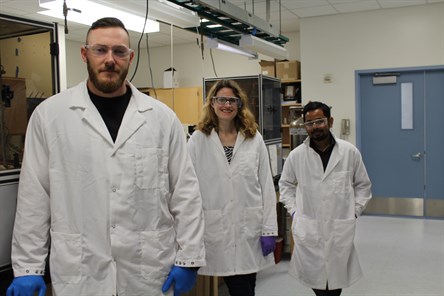Imagine a cake as large as a billionth of a meter or nanometer. You may end up with a disaster if the layers of frosting are too warm or not spread with precision. The precision, properties and fundamental structure of each layer of frosting would be difficult to measure, much less see or weigh.
Thin film coatings are the layers of frosting in industrial applications across multiple manufacturing sectors. Environmentally sustainable, water-based, solvent-free thin film coatings are the future of high performance materials.
Dr. Jodie Lutkenhaus, associate professor and William and Ruth Neely Faculty Fellow in the Artie McFerrin Department of Chemical Engineering at Texas A&M University, has received a $405,000 grant from the National Science Foundation to research ultra-thin films of polymers containing bound ions, known as ‘polyelectrolytes’.
 Lutkenhaus’ Organic Thin Films and Nanostructures Lab seeks to evaluate the ‘glass-melt’ or softening transition of these films using a suite of analytical techniques that will probe it on a molecular level. If successful, this project will shed new light on the role of water and salt in the thermal transition.
Lutkenhaus’ Organic Thin Films and Nanostructures Lab seeks to evaluate the ‘glass-melt’ or softening transition of these films using a suite of analytical techniques that will probe it on a molecular level. If successful, this project will shed new light on the role of water and salt in the thermal transition.
The nanocomposite coating is a thin film of polyelectrolyte multilayers or “layer-by-layer assembly” of desired material. Such coatings are commonly used in solar cells, optic and antibacterial, biomedical and temperature-responsive materials. Common layer-by-layer assemblies are made by processing by immersion, spinning spraying, electromagnetic or fluidic deposition of desired material on a variety of application surfaces.
“Any application you can dream of for these coatings, I assure you someone has tried it,” said Lutkenhaus. “At one point, researchers were talking about depositing it into hair as a beauty product.”
 Although thin films have been developed for a while, their exact structure is still not known. This project places a unique emphasis on salt type, where a broad range of salts with varying size, charge and water interactions are examined. Lutkenhaus seeks to investigate the unified relationship between temperature, water and salt as it governs the transition of the thin films.
Although thin films have been developed for a while, their exact structure is still not known. This project places a unique emphasis on salt type, where a broad range of salts with varying size, charge and water interactions are examined. Lutkenhaus seeks to investigate the unified relationship between temperature, water and salt as it governs the transition of the thin films.
“This will be of significant importance because this new knowledge will allow fine-tuning of the transition temperature and the physical properties associated with these materials, ultimately leading to possible new advanced applications,” said Lutkenhaus.
She explained the phenomenon of thin film glass transitions on a macroscopic scale with an example of a rubber ball. She demonstrated how the ball when dipped in liquid nitrogen solidifies and cracks when dropped on the ground. In real world applications, it is important to know if the film is rubbery or glassy. Continued fundamental research on the structure of the coatings will help Lutkenhaus engineer thin film coatings that adapts to the material to be coated.
Dr. Maria Sammalkorpi, professor of polymer chemistry from Aalto University in Finland, actively collaborates with Lutkenhaus’ lab. Her molecular models explain some of the properties in thin films. Yangpu Zhang, doctoral student in the chemical engineering department is assisting Lutkenhaus, and will be visiting Sammalkorpi for a month in Finland to conduct related research in polyelectrolyte complexes, a cousin of layer-by-layer assemblies.
Four undergraduate students in Lutkenhaus’ research group are currently assisting with the research. Lutkenhaus says this research is a good platform to introduce them to lab research as the process is water-based and therefore, safe.
“You can pretty much use any material to create a thin film coating which is adaptable, environmentally safe and stimuli-responsive,” said Lutkenhaus. “These coatings are so versatile, the consumer wouldn’t and shouldn’t know they’re there.”